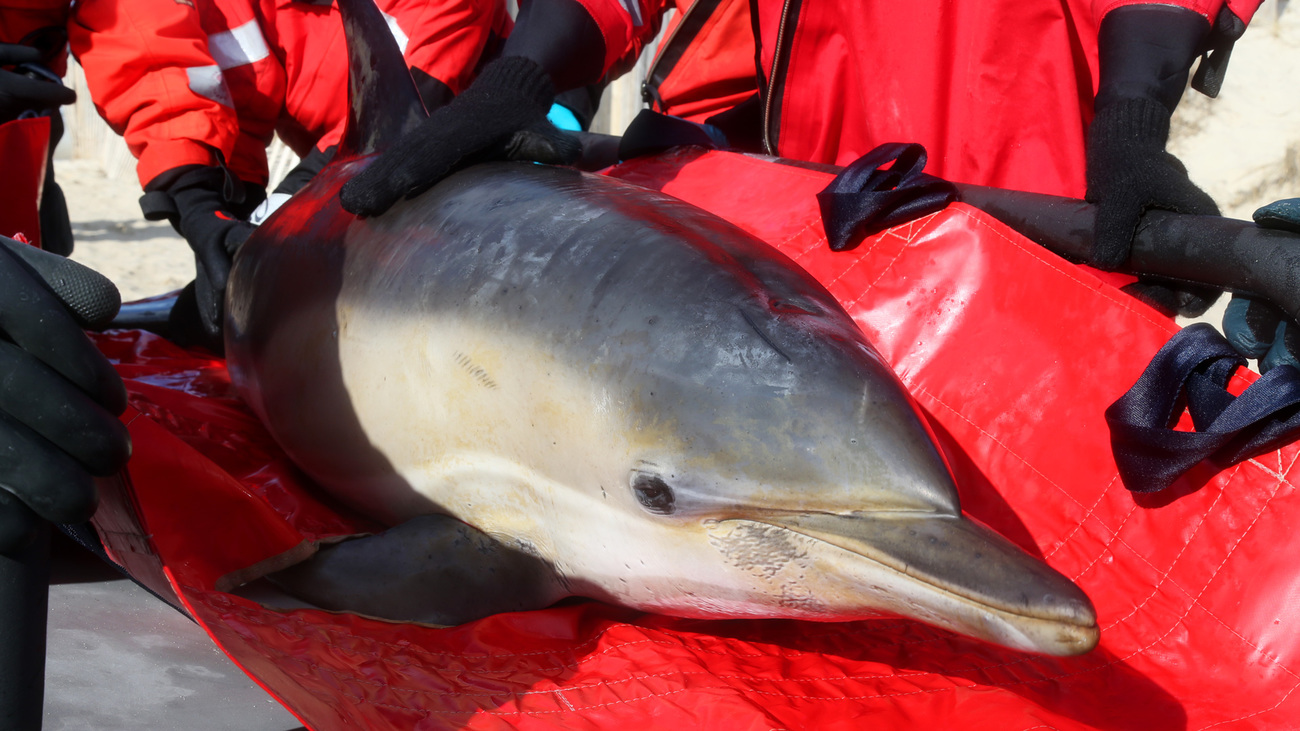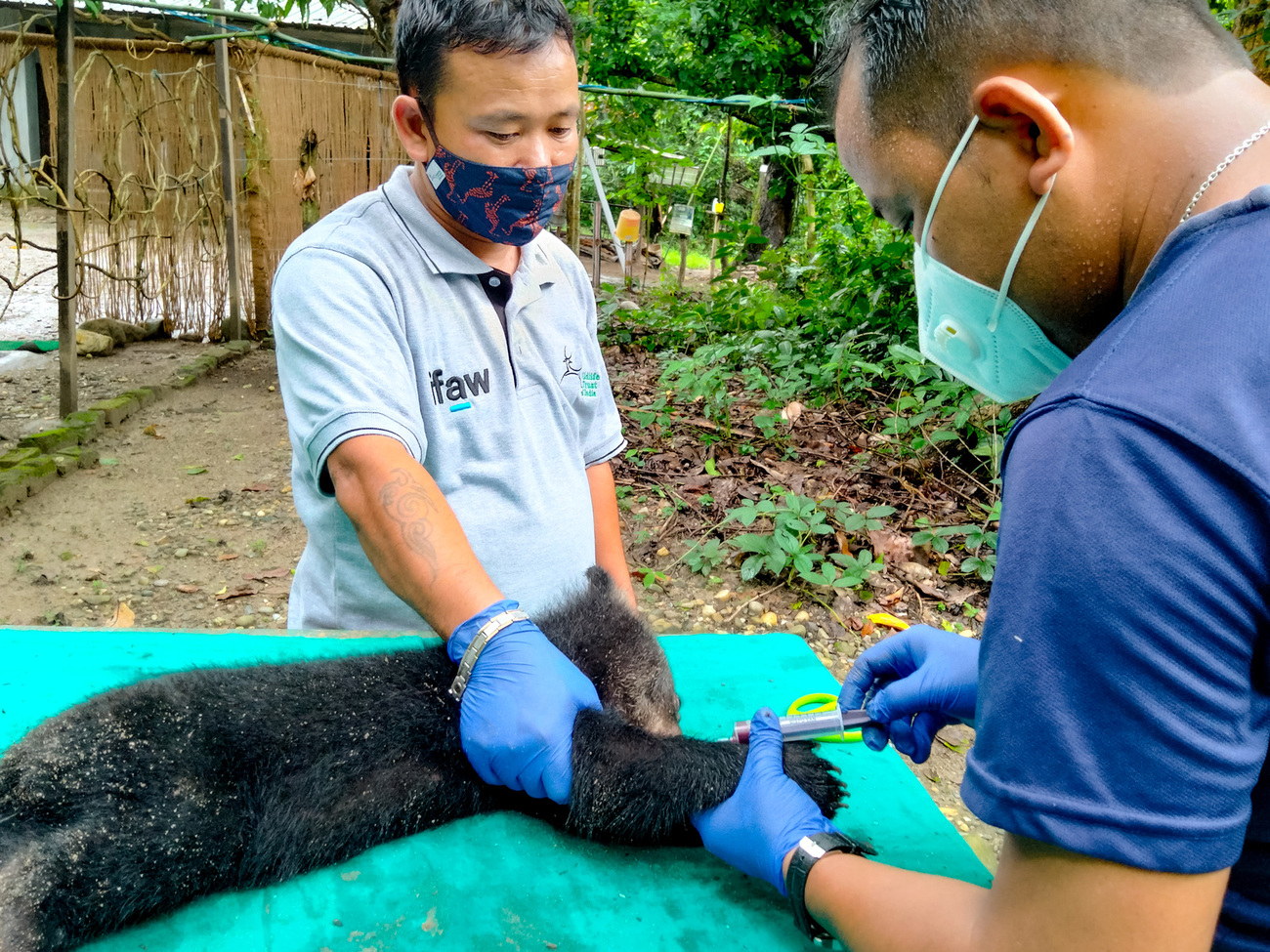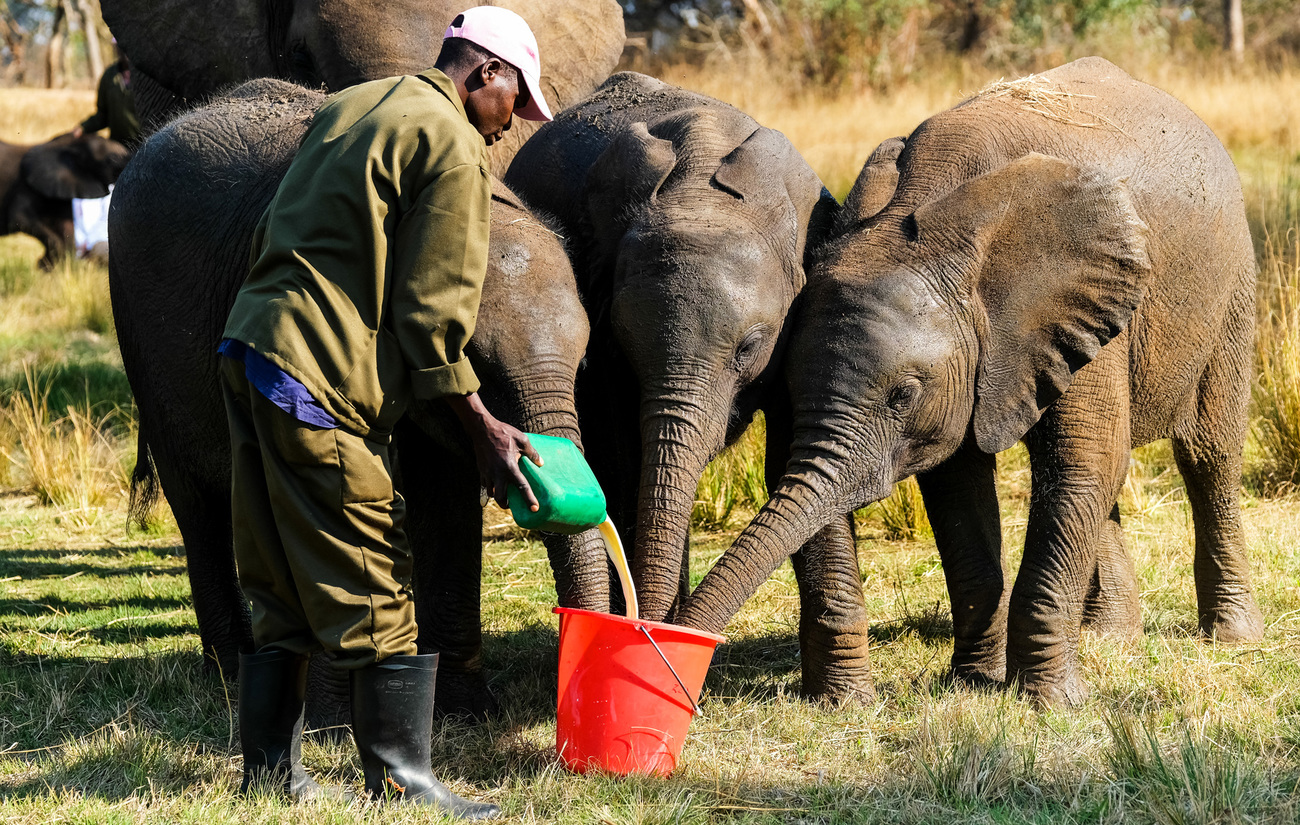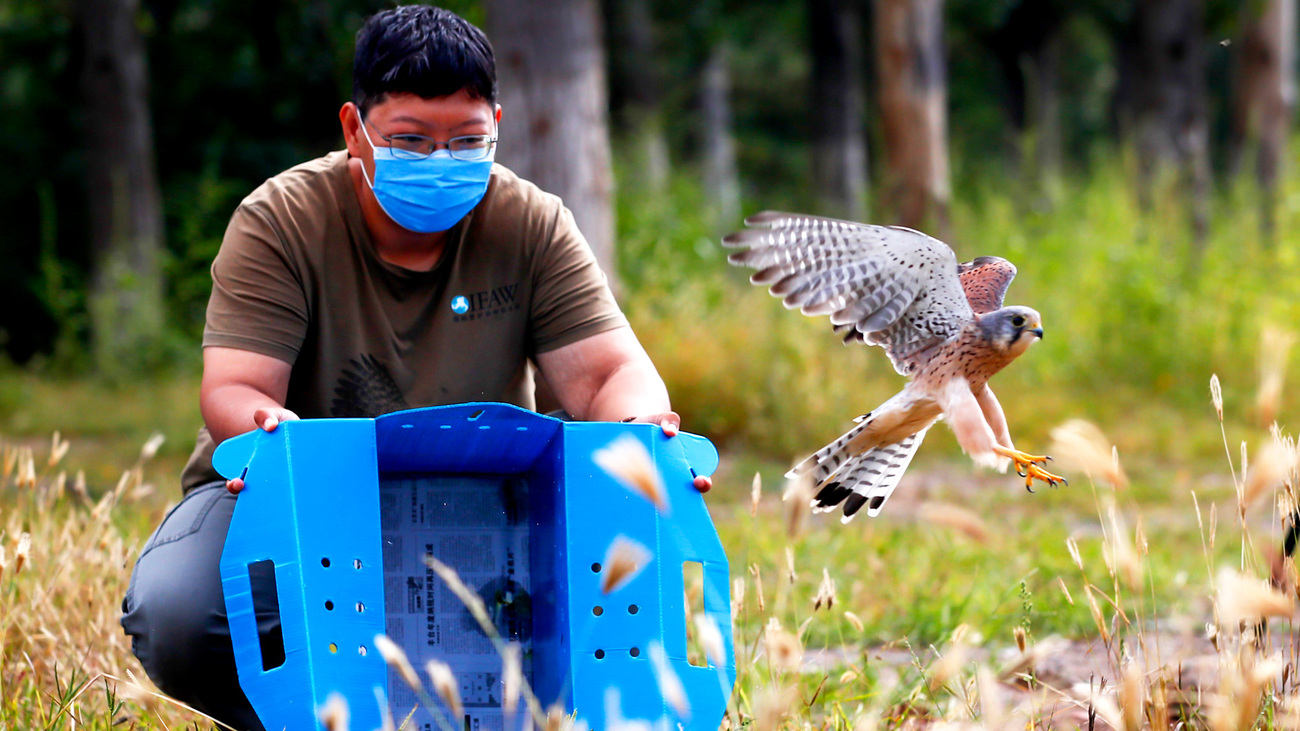Wildlife rehabilitation terms & definitions
Wildlife rehabilitation terms & definitions

Wildlife rehabilitation involves many aspects, including veterinary care, psychological stimulation, surrogate motherhood, and post-release monitoring. The goal of wildlife rehabilitation is not to keep these animals in captivity forever; it is always to bring them to a point where they can safely and successfully return to the wild and integrate into their local ecosystem.
IFAW is a global organization dedicated to wildlife rescue and rehabilitation in addition to conservation and advocacy. To learn more about our work, check out our project pages.
What are wildlife rehabilitators?
What are wildlife rehabilitators? A wildlife rehabilitator is a person who receives a permit from the government and is trained to rescue sick, injured, debilitated, and orphaned wild animals. Wildlife rehabilitators aim to provide care to these animals so that they become strong and healthy enough to return to the wild. Wildlife rehabilitators are committed to conservation and the protection of endangered species and biodiversity. They typically work alongside veterinarians.

Wildlife rehabilitators also need to be knowledgeable about local wildlife and their behaviors. They receive a lot of calls about animals that may appear to be orphaned, but oftentimes, their mothers are nearby. For example, baby deer often wait for their mothers while they are browsing for food, and they may appear to be alone. A wildlife rehabilitator would be able to tell you if that animal seems to be in danger or not if you describe the situation to them. This is why it’s crucial that you call a licensed wildlife rehabilitator when you see a baby animal if you think it might be orphaned—before touching or picking up the animal.
Wildlife rehabilitators generally do not charge money for their work, but they accept donations. Some wildlife rehabilitators operate as non-profit organizations or receive funding from larger organizations.
Some wildlife rehabilitators specialize in one species or in one type of animal. Here are some examples of wildlife rehabilitation that IFAW supports around the world.
- IFAW’s marine mammal rescue team specializes in the treatment of dolphins, seals, and porpoises.
- The Lusaka Elephant Nursery and Zimbabwe Elephant Nursery care for young elephants and other wildlife.
- The Center for Bear Rehabilitation and Conservation in India takes in Asiatic black bears.
- IFAW and WTI’s Center for Wildlife Rehabilitation and Conservation takes in rhinos and elephants in India.
- In Australia, we support the rehabilitators at Friends of the Koala and Bonorong Wildlife Sanctuary, which care for koalas and other native animals of Australia.
- IFAW’s Beijing Raptor Rescue Center in China rescues and rehabilitates birds of prey.
- The Tamanduas Institute project in Brazil takes in anteaters.
- The Lebanese Association for Migratory Birds has a rehabilitation center focusing on the care of raptors and storks.
- The Centre for Orangutan Protection has a rescue and rehabilitation center in Borneo.
- Through our Live Animals Seized in Trade (LAST) project, we help law enforcement care for animals rescued from wildlife trafficking and find them placements at wildlife rehabilitation centers.
If you’re interested in becoming a wildlife rehabilitator, try volunteering with one. You may find that you enjoy and have a passion for the work.

Wildlife rehabilitation terms and definitions
Here are some of the important terms IFAW often uses when discussing our wildlife rehabilitation work.
Canine distemper
Canine distemper is a virus that affects many different mammals, including dogs, cats, coyotes, foxes, pandas, wolves, skunks, raccoons, ferrets, seals, sea lions, and some primates. It is highly contagious. In domestic dogs, the first symptom of canine distemper is typically watery or pus-like discharge from the eyes, followed by a fever, loss of appetite, and clear discharge from the nose. As the disease progresses, it attacks the central nervous system, causing neurological symptoms such as paralysis and seizures.
Currently, there is no known cure for canine distemper. Over 50% of dogs who become infected with canine distemper die, which is why keeping your pet up to date with vaccinations is so important.
Unfortunately, domestic dogs often pose a threat to the survival of wild animals as they spread diseases like canine distemper. African wild dogs are one such species. Because they stay close together and the disease is so contagious, canine distemper can wipe out entire wild dog packs.
Through our Northern Dogs project, IFAW worked to bring veterinary services to First Nations communities in Canada that previously had little to no access to them. Over 20 years, the project has prevented domestic dogs from dying due to distemper and other diseases. Importantly, vaccinating domestic dogs prevents the spread of disease to wild animals.
Canine distemper isn’t limited to dogs. Between 2015 and 2021, communities in India found 15 leopard cat kittens and notified the IFAW-Wildlife Trust of India (WTI) Mobile Veterinary Service (MVS) unit. Our team rescued the kittens and brought them to the MVS field station at Bodoland Wildlife Transit Home. The kittens were in poor health, and two tested positive for canine distemper. These may have been the first cases of the disease witnessed in leopard cats in India.

Dehydration
While dehydration might not sound that harmful, it often contributes to declining health in wild animals and can lead to their death. Dehydration must be addressed quickly by wildlife rehabilitators, as dehydrated animals may not be able to absorb the nutrients and medicines they need.
Wildlife rehabilitators first must determine how severe a rescued animal’s dehydration is by looking for physical signs. For mammals, they can do a ‘skin tent’ test by gently pinching the animal’s skin, pulling it upwards, letting it go, and seeing how long it takes to return to its original position. You can try this at home with your own skin. The more dehydrated you are, the longer it takes for the skin to return to its original appearance. For birds and reptiles, rehabilitators look for signs like sunken eyes or thick saliva.
Introducing too much liquid right away can be dangerous, so rehabilitators then use equations to determine how much fluid an animal should have to replace what they have lost. They spread this process of rehydration over several days to ease them back into a normal state.
Wild animals that are only mildly dehydrated can usually drink water on their own. However, severely dehydrated animals often need fluids to be inserted directly into their veins or bones.
Dehydration in wildlife can have many causes. It could be the result of drought, competition with humans or other animals for resources, or habitat fragmentation. Animals can also easily become dehydrated if they are orphaned, stranded, injured, or otherwise incapacitated.
Dehydration is often experienced by stranded dolphins. IFAW’s marine mammal rescue team brings them to safety, and if they need further recovery time, they can receive treatment in our Dolphin Rescue Center. Once they are fully healed and ready to return to the wild, our team releases them to a safe site in the ocean.

Emaciation
Emaciation is the serious condition of an animal losing more than 20% of its body weight. Typically, emaciation occurs when an animal begins to process body fat and protein in the absence of caloric intake. Animals experiencing emaciation may show other signs like vomiting, diarrhea, and fever.
Malnutrition often leads to emaciation, and it can result from injury, habitat loss, or being stranded or orphaned. Wild animals can also become emaciated if they are kept in captivity or smuggled in the illegal wildlife trade and aren’t given proper nutrition. In whales, emaciation can be the result of becoming entangled in discarded fishing gear.
For wildlife rehabilitators, one of the most difficult parts in dealing with emaciated animals is resisting the urge to simply feed them. Nursing an emaciated animal back to health must be done very slowly and carefully, and only by professionals.
Enclosure
Enclosures are fenced-off spaces where wild animals are kept at rehabilitation centers, zoos, or sanctuaries. Enclosures vary in size and shape between animal species.
While returning to the wild is the ideal happy ending for all wild animals that are rescued and rehabilitated, it isn’t always possible. Sometimes, a wild animal has become too injured, sick, or traumatized and suffers lasting effects that will hinder its integration into a wild group and its survival without human care. In these cases, wildlife rehabilitators strive to provide the animal with the utmost care and a life similar to what it would experience in its natural habitat.
For example, aviary enclosures for rehabilitated wild birds should be wide, long, and tall, giving the birds space to use their wings. They should also have plenty of suitable natural branches for perching. Enclosures for lions and other big cats should ideally be outdoors and include natural vegetation and water sources like ponds, which encourage playing and grooming. The needs of individual animals should be assessed in determining the appropriate enclosures. For instance, some animals might thrive best in a group setting, while others are better off living solo.
IFAW has supported the care of several big cats at our partner sanctuary Wild Animal Rescue in Ukraine. These cats have suffered from being in too-small enclosures with their original owners, who have either abandoned them due to the war or have surrendered them to the rescue center. An important part of our work with Wild Animal Rescue has involved supporting them while they locate suitable forever homes for these lions and tigers, ideally where they can thrive in large, outdoor spaces with other big cats.
Hyperthermia and hypothermia
Animals have a small window of body temperatures within which they can survive. If they become too hot or too cold, their bodies can no longer perform basic functions. Though the ranges differ between warm-blooded and cold-blooded animals, both types of animals can experience hyperthermia and hypothermia. Hyperthermia is the life-threatening condition of having too high of a body temperature, while hypothermia is the life-threatening condition of the body temperature being too low.
To prevent hyperthermia and hypothermia, animals use a variety of techniques. Warm-blooded animals—including all mammals and birds—have automatic bodily functions that cool them down and warm them up, including sweating, panting, and shivering. Cold-blooded animals, on the other hand, do things like basking in the sun or burrowing in a den to maintain their body temperatures.
Hypothermia and hyperthermia can be caused by a number of factors. Animals may become stranded in the sun or in the cold, get caught in a snare, become dehydrated due to drought, or experience abnormal temperatures in their habitats. Hyperthermia and hypothermia are also risks when dealing with wild animals in captivity, as they may not have the means of regulating their body temperature if they’re kept in improper enclosures. When wildlife rehabilitators administer anesthesia, this also can put animals at risk of hyperthermia or hypothermia, as they can’t properly regulate their temperatures when unconscious.
IFAW responds to disasters around the world, rescuing animals from wildfires, floods, storms, earthquakes, and more. Many animals impacted by flooding in France caused by severe weather suffered from hypothermia. We supported local rescue centers in the rescue and rehabilitation of small mammals, birds, tortoises, turtles, seals, and more.
Incubator
One important tool used in wildlife rehabilitation is an incubator. An incubator is an enclosed space, similar to an oven, that provides warmth and shelter for young animals. Powered by electricity or gas, incubators have precise temperature controls that allow rehabilitators to closely monitor and care for these animals in their vulnerable states.
Often, incubators are used on baby birds or unhatched eggs to mimic the warmth they would receive from their parents sitting on them in a nest. Newborn mammals often also are kept in incubators, as they are too young to regulate their own body temperature. Young birds and small mammals are often born featherless or hairless, which makes them much more vulnerable to the cold.
Post-release monitoring
After rescue and rehabilitation comes release, if an animal is fit to return to the wild. However, wildlife rehabilitators often don’t let an animal roam free without keeping a close eye on them, at least for some time. We use post-release monitoring as a tool not only to monitor these individual animals, but also to learn more about their populations and species as a whole.
At IFAW, we conduct post-release monitoring of elephants cared for at our Lusaka Elephant Nursery and Zambia Elephant Nursery. We fit elephants with GPS collars when they are ready to be released, so we can track their locations and integration into wild herds. The data these collars provide also help us predict elephant herd movements and prevent human-wildlife conflict.
We also engage in post-release monitoring of the dolphins saved by our marine mammal rescue team on Cape Cod, US. Satellite tags are small devices attached to dolphins’ fins in a minimally invasive procedure. They are temporary, transmitting data for up to a few months on a dolphin’s location, swim speed, and whether they have survived or become stranded again. IFAW has tagged over one hundred dolphins and porpoises to date, which has provided us with invaluable information on their whereabouts, patterns of behavior, and survival rates.

Pre-release facility
Part of releasing rehabilitated wild animals back to their natural habitats involves ‘soft release’, which allows them to take their time and take small steps to reintegrate back into the wild. This involves a pre-release facility, which is an enclosure located close to the animal’s release site. They spend time in this enclosure and in the area around it, but they are given the chance to return to the enclosure for food, water, and shelter as they adjust to their new surroundings. This support is reduced gradually over time, until the animal is ready for life in the wild.
IFAW has supported the use of pre-release facilities for animals like Asiatic black bears, koalas, wombats, orangutans, elephants, and more. One pre-release facility we support is in Panda Masuie Forest Reserve in Zimbabwe, where elephants can gradually reintegrate back into the wild.
Release
Release back to the wild is the end goal for every wild animal we rescue and rehabilitate. Wild animals are not meant to be pets and should not be kept in enclosures or experience contact with humans if they do not have to. This is why IFAW supports a three-stage process of rescue, rehabilitation, and release for wildlife around the globe.
To support the release of wild animals, we use special care techniques to prevent them from becoming too accustomed to humans, as this hinders their ability to survive in the wild. One method we employ is the use of tree costumes and bird puppets to feed baby birds of prey during their stay at our Beijing Raptor Rescue Center. Another important way to help animals prepare for their release into the wild is to make sure they have socialized with other members of their species.
When rehabilitating and releasing wild animals, it’s critical to ensure that they have a safe home to return to. That’s why, alongside our rescue, rehabilitation, and release efforts, IFAW also works to protect and conserve the landscapes into which we release wildlife.

Zoonotic disease
A zoonotic disease is an infection that can spread between people and animals. They can be caused by viruses, bacteria, parasites, or fungi. Some, like rabies, are severe and life-threatening for both people and animals, whereas others are mild. Examples of zoonotic diseases include COVID-19, Lyme disease, avian flu, AIDS, Ebola, and anthrax.
The spread of zoonotic disease is most often the result of human exploitation of and improper contact with wildlife. Even before the COVID-19 pandemic, zoonotic diseases caused about one billion cases of illness and millions of deaths each year, while costing the global economy billions of US dollars. The illegal wildlife trade, bushmeat hunting, the exotic pet trade, and habitat destruction are all catalysts behind the spread of zoonotic disease.
Biodiversity plays a critical role in mitigating the spread of zoonotic disease, as does limiting our interactions with wild animals. We can also fight zoonotic disease by vaccinating our domesticated animals and keeping our dogs and cats indoors.
IFAW supports the rescue and rehabilitation of wild animals around the world and the conservation of the landscapes and oceans where they roam.
Related content
every problem has a solution, every solution needs support.
The problems we face are urgent, complicated, and resistant to change. Real solutions demand creativity, hard work, and involvement from people like you.